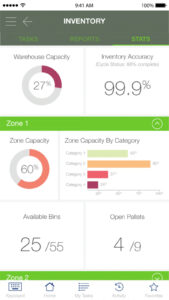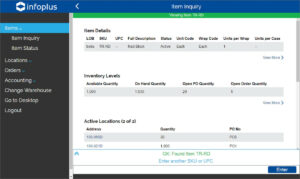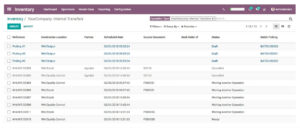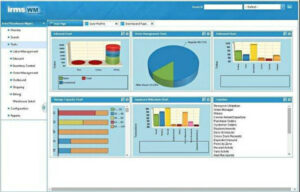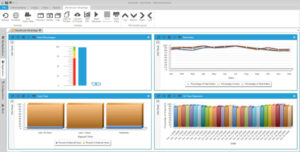This post will explain warehouse inventory software. This post will assist you rapidly compare and examine the best warehouse management system (WMS) and other operations management systems. Warehouse management systems can help to deal with common obstacles in warehouse management, like time management, the accuracy of inventory tracking, and redundant procedures. Possibly this is why warehouse automation systems and software are expected to be a $22.4 B+ market by 2021. Needless to say, this pattern is growing.
You may now be looking to execute your very first digital warehouse process or to simply update the software resolution you previously have in place. That’s why I’ve selected to highlight a few of the very best warehouse management systems and respond to some FAQs about WMS software.
10 Best Warehouse Inventory Software Systems In 2024
In this article, you can know about warehouse inventory software here are the details below;
I will also discuss what an automated warehouse system can do for you and supply a simple comparison of premium warehouse inventory management software. Each inventory management system listed below merits in its own right. Continue reading to read more about each one so that you can select the best warehouse management software for your requirements.
Have some concerns about warehouse management systems? You’re most likely not the only one. Browse our list of usually asked topics below.
What is warehouse management system?
A warehouse management system is a digital instrument developed to support, control, and optimize normal warehouse workflow. Normally, these processes include the similarity inventory management and inventory accuracy, choosing and shipping, fulfillment, auditing, and more. A warehouse management system might be consisted of with your business resource preparation software and supply chain management (SCM) software and it might be a separate software.
How do warehouse management systems work?
Warehouse management systems work separately, depending on the WMS software you choose. Nevertheless, you can expect each to have comparable standard functionality that includes items like inventory tracking, handheld barcode scanners or radio-frequency identification (RFID) scanners, label and packaging slip printing, delivery tracking, browsing pallet, and inventory storage, supporting personnel, and more.
What are the advantages of warehouse management systems?
Warehouse management software has numerous benefits, some of which include: lowered operating costs and labor expenses, optimized inventory tracking, just-in-time (low stock, fast replenish) warehouse inventory abilities, security practices, inbound/outbound control, billing management, CRM, and far more.
What are some free warehouse management systems?
Free warehouse management software might suffice for little warehouses. Choices consist of Odoo, PartKeepr, ABC Inventory, Stockpile, and Skyware.
Warehouse Management Software Comparison Criteria
What are we searching for when we choose WMS software for review? Here’s a summary of my evaluation criteria:
- Interface (UI): Is it clean and attractive?
- Functionality: Is it easy to discover and master? Does the company offer excellent tech assistance, user support, tutorials, and training?
- Functions & Functionality:
a.Scalability– Is it simple for the system to grow in addition to your business?
b.Complete Transaction Management– Does the tool manage every action of the warehousing procedures (ie. getting, order and sales order tracking, order picking, shipping, and so on)?
c.Handle Multiple Business Channels– Can the tool deal with direct-to-customer, ecommerce, retail, and wholesale?
d.Reporting and analytics– Are the reporting tools robust, personalized, versatile, and visually appealing? Can men be exported into another, popular files types for review?
- Integrations: Is it simple to combine with other tools alike your retail operations platform and CRMs? Any pre-built unions? Will it integrate with any current supply chain management means, enterprise support preparation tools, or transport management systems you have in location?
- Worth for $: How proper is the rate for the functions, capabilities, and use case? Is prices clear, transparent, and versatile?
Summaries Of Each Warehouse Management Software System
Here’s a brief review of each of the WMS systems that remain featured on this leading 10 list.
1. NetSuite— Best warehouse inventory software with built-in eCommerce marketing tools
NetSuite is a cloud-based ERP company software service that combines monetary, capital, payroll, inventory, and more into one tool, so users have clear presence and total control of their company.
The set of tools covers SuiteCommerce, a software solution meant specifically for eCommerce, as well as tools for warehouse and inventory management.
The SuiteCommerce service supports both B2C and B2B ecommerce in one tool, so users offering more than one type of great or service can manage whatever their company offers.
NetSuite SuiteCommerce consists of features for order management for several channels, real-time inventory presence, and order processing. The suite also consists of marketing, point of sale, and content management performances for a holistic way to handle ecommerce. Users can release new promotions, create landing pages, or release brand-new material. Drag-and-drop tools enable you to modify pages and manage content. The suite of tools also consists of the capability to work on numerous variations of your site at the same time and after that schedule it for future implementation.
As a multi-tenant SaaS ecommerce software and NetSuite is scalable and allows for easy deployment, uncomplicated upgrades, and extensibility. Benefit from new features and automatic updates with every release, ensuring your website is always on the most recent commerce technology. A selection of extensions are offered to boost your website.
Rates for NetSuite is available upon demand. NetSuite uses a totally free item tour.
Pros
– Ecommerce marketing, inventory management, and order management in one option
– Order processing and management for several channels
– Supports B2B and B2C in one platform
Cons
– Lack of transparency on prices
– Lack of out-of-the-box 3rd celebration integrations
2. Mobe3 WMS— Best for optimizing warehouse layout and picking routes
Mobe3 WMS order help you structure your warehouse plan & enhance your direct picking paths with SmartBarcode scanning and system-directed selecting, developed to help eliminate manual mistake and improve labour efficiency.
This software was easy to execute and quick to get up-and-running. Mobe3 WMS has a great training structure and an interface that is simple to determine and browse. They scored extremely on the use section of the evaluation. Also check logitech webcam software.
This tool is versatile and configurable and can integrate with your ERP as well as other systems like TMS, MES, weigh scales, and robotics like Slack.
One con for the software was kept in mind was that there were a couple of problems with compatibility with previous iOS versions and other older smart devices.
3. SphereWMS— Best for warehouse inventory tracking
SphereWMS’ warehouse management software permits you to gain control, performance, and exposure over your warehouse operations with wireless barcode scanning, real-time web exposure and reports, flexible modification, and an iPhone/iPod app.
SphereWMS scored favorably in the integrations area of the examination requirements, as they have a robust list of third-party port options that are easily noted on their site. Any business that requires a versatile WMS that plays well with others would gain from Sphere.
SphereWMS offers you with alternatives for combination with leading e-commerce sites and online shopping carts. Integration alternatives include Amazon, ApparelMagic and BigCommerce, Blue Cherry, Channel Advisor, ClickFunnels and CS.cart, Etsy, Foxycart, Houzz, Joor, Netsuite and PayPal, PrestaShop, Salesforce, Squarespace, WooCommerce, & more.
1 critique of this tool is that some celebrations can be a bit troublesome, though the additional intricacy is usually meant to ensure detailed details capture. Though prices plans are versatile, this software tends to be on the more expensive side comparatively.
4. Infoplus— Best for custom-made reporting dashboards
Infoplus is a full WMS with incoming and buying, outbound and shipping, inventory control, foundation, customized reporting, control panels, management by exception, low stocks and stock controls, customer website, and real-time order and delivery tracking.
As a WMS, Infoplus is extremely versatile in their pricing prepares with some lower-cost choices for start-ups and small businesses. They are also extremely transparent with their prices plan on their website. Therefore, they scored well in the assessment for Value for Cost.
Combinations consist of over 120 connections with carts, providers, and more. Some examples consist of Amazon Seller Central, Etsy, Cratejoy, HSN, Walmart Marketplace, Walmart DSV (Drop Ship Vendor), ChannelAdvisor, and more.
One con is a lack of, or substandard variations of, reporting and stats tools. This software is doing not have in real-time reporting along with information import/export.
5. Odoo— Best all in one option for warehouse and sales applications
Odoo is a series of warehouse & buying solutions divided into a household of apps that cover sites, sales, operations, and fertility tools. Their warehouse management software practices order cases and electronic RFQs for automatic replenishment of your supply chain. Also check document management software.
This software enables the totally free use of 1 of their applications and a modest expense for the addition of another. If you discover that you can use 1 or 2 of their tools, this is easily the most budget-friendly choice on this list, so they scored well in Value for Cost.
Third-party combinations can be connected through Zapier. Nevertheless, Odoo provides a full suite of software and various first-party apps of their own so external plug-ins are not highlighted on their website.
The absence of third-party combination choices might be troublesome to some users who are wanting to incorporate their everyday job management tools into this software. Customization can be cumbersome.
6. SkuVault— Best for third-party combinations
Among the important things SkuVault stands out at is the sheer variety of ready-to-go combinations they have available with their system, a choice of which is listed below. Hence, they scored highly in the integrations section of the evaluation.
Combinations include 3dcart, Amazon, Anvizent, Back Market, Big Commerce, eBay, Ecomitize, Etsy, Feedonomics, GeekSeller, InfoCon Systems, Jet, Logic Broker, Magento, Microsoft Dynamics, Miva, Mozu, Oracle Netsuite, Quickbooks, Salesforce, RetailPro, Sellbrite, ShipRush, Shopify, Square, WooCommerce, Zero, and much more.
A disadvantage of SkuVault is that a few of the crucial functions can be frustrating to browse and execute; for example, the order creation process for deliveries and inventory removal could be better arranged.
7. IRMS360— Best for supply chain tracking and inventory writing
Aptean irms 360 is a cloud system warehouse management system that supplies presence and control over your operations. Whether you are handling a single warehouse or a global enterprise, irms|360 assists you get the most out of your resources and space.
Aptean has a big list of suitable add-ons and connectors for marketing, ecommerce, and CRM; therefore, they scored well in the examination factor to consider for combination possibilities.
Combinations include Alfresco, Centric CRM and Marketo, Microsoft CRM and AX, Open Bravo, Oracle and QuickBooks, SAGE X3, Salesforce.com, SAP and SugarCRM, Vtiger CRM, Amazon RDS, Amazon Redshift, Amazon S3 and AS400, DB2, Derby DB, Exasol, eXist-DB, Firebird or Google Storage, Greenplum, H2 & HSQLDB, Informix, Ingres, InterBase, JavaD and JDBC, MaxDB, Microsoft OLE-DB, Microsoft SQL Server, MySQL, Netezza and Oracle, and more.
A few cons to see are 1) a really minimal character count when it concerns document entitling, and 2) a weak search function that often brought up inaccurate or irrelevant results.
8. Highjump— Best for warehouse automation to improve performance
Highjump, making a rebrand to Körber, is an Agile WMS service for the vibrant supply chain. Highjump supplies technology to improve productivity, lower operating expenses, deliver on shrinking order turn-around windows, and optimize throughput and capability.
The program is very robust and has lots of capabilities for advanced users to suss out if so inclined. The UI has improved version-to-version, getting more modern-day and intuitive with continuous fixes.
HighJump incorporates with all significant ERP publishers and also supplies custom combination services for tradition and custom-built ERP systems. Examples consist of Acumatica, Microsoft Dynamics GP/AX/NAV/ SL, NetSuite, Sage, SAP Business One, SAP R/3, Oracle ERP, and more.
Highjump has a little a high learning curve, particularly when you dive deeper into the software. They lost a few marks in functionality because of this; nevertheless, it will mostly be something that impacts the administrators, not everyday users.
9. Blue Link ERP— Best for small to medium size services
Blue Link ERP is an all-in-one option created for small to medium-size businesses, primarily wholesalers and distributors. As a fully incorporated system, Blue Link ERP provides functionality for handling inventory, accounting, order entry and processing, and warehouse management. Also check best church presentation software.
This tool has actually an arranged and practical user interface, with information and images plainly laid out for readability and availability. It has a familiar UI that each level of user involvement can understand. Therefore, it scored well in the UX assessment consideration.
Blue Link ERP details that it integrates with tablets and barcode scanning gadgets, common carriers, and rate shopping applications; however, their site didn’t name which private third-party applications were covered by this.
For the onboarding procedure, they really offer in-person consulting, execution, training and assistance services all offered by their group of internal professionals. This is readily available to all customers.
10. Manhattan— Best supply chain management through advanced AI, artificial intelligence, and proprietary algorithms
Records and sends inventory items utilizing the comprehensive WMS database screens above.
Manhattan’s WCS order streaming enhances satisfaction and throughput for both WAVE and WAVELESS order fulfillment concurrently in a single platform. Streamline receiving and delivering to facilitate cross-docking and speed up back-ordered items.
Manhattan’s WCS does a few things actually well, like using a devoted WMS group that can compose your scripting from SQL Server. In addition, the environment was easy to learn and master.
Manhattan WMS didn’t note any integrations on their site.
A lack of specified integrations or used connections through a market is a substantial downfall for this software. Therefore, they lost some marks in the Integrations area of the evaluation.
Manhattan commences at $1000 for a SaaS permit and $2000 for on-premise.



